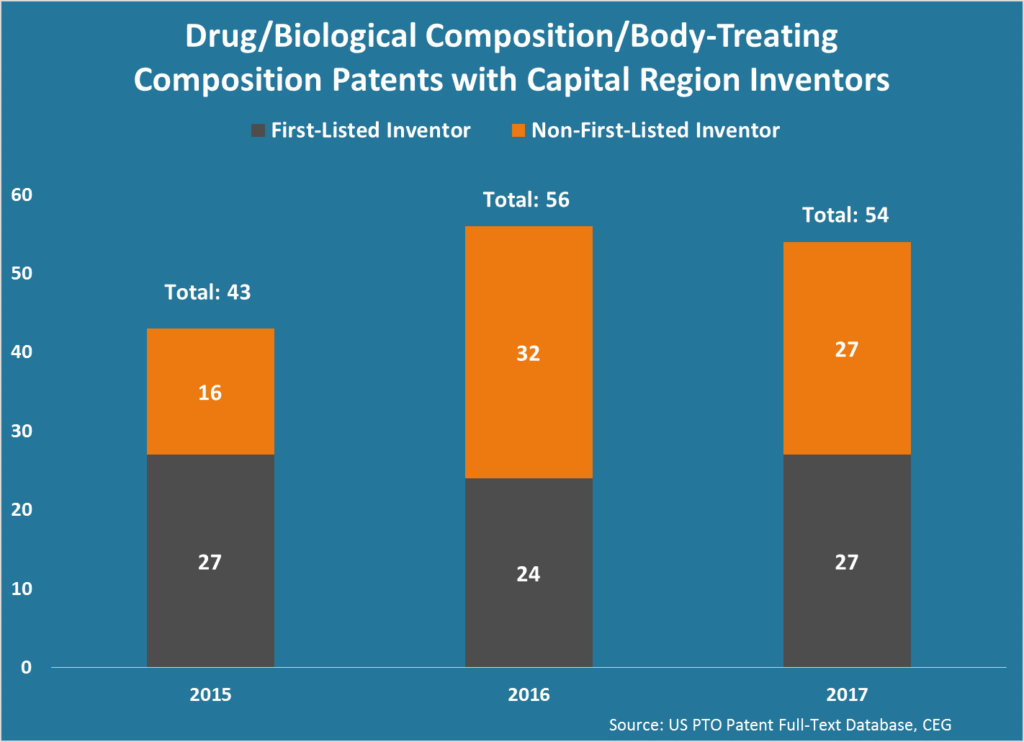Capital Region Researchers Drive Drug Discovery for Dozens of U.S. Biotech Firms
As Regeneron Pharmaceuticals helps reshape the Capital Region’s manufacturing landscape, we are also seeing local scientists making their mark in the drug discovery industry. Over the past three years, Capital Region inventors have aided nearly 70 companies and institutions obtain more than 150 patents for drugs, biological compositions and other body-treating compositions, according to a Center for Economic Growth review of patents listed in the U.S. Patent and Trademark Office (PTO) Patent Full-Text and Image Database.
Between 2015 and 2017, the PTO issued 153 patents in the Cooperative Patent Classification (CPC) A61K class and with at least one listed local inventor. In addition to covering drugs used for fighting diseases or abnormalities, this class covers imaging agents for diagnostic applications, dental compositions and cosmetics for personal hygiene. Capital Region inventors were first-listed inventors in more than half (78) of those patents.

High Tech Patents
Nanotechnology drove many of the patents worked on by local inventors. General Electric, which has its Global Research headquarters in Niskayuna, led the region with 18 patents with local, first-named inventors during the three-year period. Many of those patents were for nanoparticles for diagnostic imaging, such as X-ray or computed tomography. Behind GE was Nanopharmaceuticals, a spinoff from the Albany College of Pharmacy and Health Sciences’ Pharmaceutical Research Institute (PRI). Many of its patents related to nanoparticles for thyroid hormone analogs.
Mousa A. Shaker, PRI’s executive vice president and chairman, and Zenith Epigenetics, a Calgary, Alberta firm, both trailed Nanopharmaceuticals with eight patents with local, first-named inventors. Shuang Liu, a former AMRI drug discovery project leader and the president and co-founder of the emerging drug discovery firm ConSynance Therapeutics at the University of Albany’s Health Sciences Campus, was the first-named inventor for several of those Zenith Epigenetics patents. Other Capital Region assignees with several patents listing local inventors included AMRI (5), Albany Medical College (4), SUNY Research Foundation (4) and Regeneron (3).

Capital Region Pharma Firms
Although Regeneron only had three patents listing local inventors, the Westerchester-based firm actually had 187 patents assigned to it between 2015 and 2017. In 2017 alone, the company had 77 patents assigned to it – up 57 percent from 2015. Nearly half (92) of its patents assigned during the three-year period were in the A61K class while 153 were classed as peptides and 91 as microorganisms or enzymes, among other classes. (Patents can be listed under multiple CPC classes). Regeneron has approximately 564,000 square feet of research, manufacturing, office and warehouse space in East Greenbush. Since 2012, the company has more than tripled its R&D spending to $2.05 billion.
In 2016, Capital Region colleges and universities spent $105 million on life sciences R&D and local institutions, government agencies, nonprofits and private firms in 2017 received $54.6 million in funding from the National Institutes of Health (NIH). Examples of Capital Region-based pharmaceutical firms that have received Small Business Innovation Research (SBIR) or Small Business Technology Transfer (STTR) grants from NIH or the National Science Foundation (NSF) include:
• Breonics, Watervliet: $4 million since 2001
• Glauconix, Albany: $975,000 since 2015
• HocusLocus, Albany: $2.2 million since 2011
• Pulmokine, East Greenbush: $7 million since 2010
CEG and the Life Sciences
The Capital Region Economic Development Council’s Life Science Cluster plan, outlined in the CREDC’s 2017 Progress Report, leans heavily on CEG to advance its implementation. CEG has a long history of working with biotech firms through its Bioconnex network and its National Institute for Standards and Technology (NIST) Manufacturing Extension Partnership (MEP) center. To grow the region’s life sciences cluster, which includes pharmaceutical companies, CEG is engaged in the following:
• Developing a strategy to advance and attract firms in the biotechnology, medical device manufacturing and pharmaceutical fields to the Capital Region.
• Promoting the Capital Region’s life sciences R&D assets and opportunities at industry conferences worldwide, such as the BIO CEO & Investor Conference in New York, BIOMEDevice Boston and the MedTech Conference in Philadelphia.
• Helping establish and grow life sciences startups, such as Vital Vio, Speech Cradle and Ultradian Diagnostics, through its involvement as an Innovate 518 operational partner and a regional technology center under the New York Manufacturing Extension Partnership program.
• Hosting speed mentoring events to introduce local college students to life science career opportunities in the region.
• Boosting the region’s talent pipeline by helping Hudson Valley Community College create a manufacturing jobs bootcamp and launching a Manufacturing Association of New York Apprenticeship pilot program in the Capital Region.
• Creating a catalog of the resources at and services provided by Capital Region incubators, accelerators and co-working spaces.
Don’t miss these insights into the trends that are shaping the Capital Region’s economy. Sign up for CEG’s e-news and follow us on:














